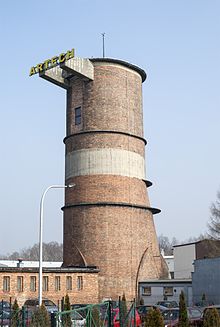Kopalnia Węgla Kamiennego Rymer
The Rymer hard coal mine (Polish: Kopalnia Węgla Kamiennego Rymer ; German name Römergrube ) is a decommissioned hard coal mine in Rybnik-Niedobczyce , Poland.
history
The coal fields "God bless you", "Ignatius", "Karl" and "Johann Jakob" were suggested in 1841 by Carl Friedrich August Cuno from Ratibor . Cuno did not strive to develop the fields, but sold his rights on. It was only after Isidor Mamroth acquired the prospecting rights in 1872 that the "Mamroth" and "Anna" shafts were sunk down to a depth of 39 meters and in 1883 the first coal was extracted. The third "Oskar" shaft (54 m) was connected to the "Mamroth" shaft by a cable car. Because the colliery initially had no rail connection, the coal was initially transported away in carts. All three shafts no longer played a role in the further development of the mine.
Neighboring the Johann Jakob coal mine was the Römer mine with the fields "Vincenzglück", "Wilhelmsbahn", "Hans Reinhold" and "Marienssegen". Although these coal fields were awarded to Prof. Karl Kuh in 1858, they were also not opened up and promoted. Even after the takeover by Carl Wittgenstein, the director of the Prague iron industry company, it was not put into operation. Rather, it was leased to the neighboring Emma mine in 1894.
The termination of the lease and the unification of the Johann Jacob and Römer mines on July 1, 1896 marks the official founding date of the colliery, which was initially called Johann Jacob and from 1903 was called Römergrube .
In the following years the colliery was systematically expanded and finally reached an area of 12.8 km². The coal fields "Evashöhe", "Emiliens Ruh", "Carl Adolph I", "Else", "Milde" and "Göppert" were leased, a sorting plant and their own electrical station were built and the "Carl / Karol" shaft was dug (193 m; double funding) and a weather shaft called "Janusz". A wash with an output of 125 - 130 t / h was added in 1913. At this point in time, the main extraction took place on the 2nd level at 182 m and, in addition to the lower and upper seam, also built the four seams IV (thickness 1.10 m), V (1.55 m), VI (1.40 m) m) and VIII (1.64 m).
In 1903 the mine was acquired by Fritz von Friedländer-Fuld , who already owned the Emma in Radlin and Anna in Pszów mines . They were all brought together in the Rybnik coal union based in Berlin. All three mines together had a rights of 137 km². Neither the division of Upper Silesia in 1922 nor the Polish Mining Act of 1930, which replaced the Prussian Mining Law of 1865, changed this ownership structure.
In 1919 the construction site of the idle Beatensglück mine was added to the mine.
In the years 1925–1930 the Roman mine was extensively modernized. The "Karol" shaft received an electric hoisting machine, electric locomotives were used for underground transport and the boiler house was extensively expanded. In 1939 mining took place on the 430 m level.
In 1936 the mine in honor of the first governor of Silesia, Józef Rymer , in Rymer renamed.
After the outbreak of the Second World War, the mine - like the Hoym-Laura / Ignacy , Anna , Emma and Rydułtowy plants - was placed under German administration and exploited by the Reichswerke Hermann Göring . During this time, all preparation and repair work was neglected and coal production was ruthlessly increased from 722,218 t (1940) to 1.20 million t (1944). To achieve this goal, from 1942 prisoners and prisoners of war from the nearby prison camps in Rydułtowy and Rybnik were used. In 1944 their number reached 400.
Although production dropped briefly to 300 t per day at the end of the war, the reconstruction began quickly. First, the sinking of the "Szymanski" weather shaft with a depth of 457 meters was started, after which both the washing and the headframe were modernized. Scraper conveyors and double cutting rollers were also soon used for coal extraction and its transport.
Thanks to these and other measures, it was possible to gradually increase production up to a maximum of 1.36 million t in 1973. After that, the production curve flattened and the mine had to stop production on July 1, 1995. The construction site was handed over to Chwałowice , the shafts filled and with the exception of the tower above the "Szymanski" shaft, all headframes and daytime facilities were demolished.
In the end, the mine had the following shafts:
- "Janusz" shaft on the main conveyor system; liquidated in 2000
- "Karol" shaft in the same place; liquidated in 2002
- "Szymanski" weather shaft, also transport of tailings; liquidated in 1999
- "Marcin" shaft; had various functions over time. Served as a weather shaft for "Chwałowice" after the shutdown of Rymer
Funding figures
1912: 527,582 t; 1938: 678,340 t; 1970: 1.25 million t; 1979: 2.59 million t
Web links
- Photos and a very short outline of the history of Rymer at http://eksploratorzy.com.pl/viewtopic.php?f=21&t=10698 (accessed on August 24, 2016)
- The SITG (Stowarzyszenie inżynierów i techników górnictwa zarząd głowny) has a detailed information on the website http://www.sitg.rybnik.pl/kopalnie-zlikwidowane-w-rop/rybnik-rymer.php (accessed on August 25, 2016) historical treatise on the Rymer mine (see also sources) published.
literature
- Jerzy Jaros. Słownik histoynczny kopalń węgla na ziemiach polskich . Katowice 1984.
- Yearbook for the Upper Mining District Wroclaw . Phoenix Publishing House. Katowice, Breslau, Berlin. 1913. Digitized version at http://www.dbc.wroc.pl/dlibra/publication?id=3349&tab=3 before (last accessed on May 5, 2015)
- Kurt Koenig. Coal mining in Upper Silesia from 1945–1955 . Scientific contributions to the history and regional studies of Eastern Central Europe. Published by the Johann Gottfried Herder Institute. Marburg 1958.
- Bernard Walla, Andrzej Adamczyk. Izba Pamięci Kopalń Zlikwidowanych w Rybnickim Okręgu Przemysłowym. Text downloaded as an Internet file from the above URL address on August 22, 2016.
Coordinates: 50 ° 3 ′ 30.3 ″ N , 18 ° 29 ′ 55.1 ″ E
